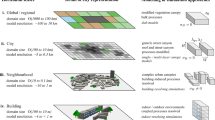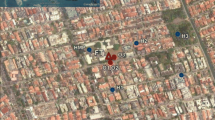Abstract
The UK Met Office has introduced a new scheme for its urban tile in MOSES 2.2 (Met Office Surface Exchange Scheme version 2.2), which is currently implemented within the operational Met Office weather forecasting model. Here, the performance of the urban tile is evaluated in two urban areas: the historic core of downtown Mexico City and a light industrial site in Vancouver, Canada. The sites differ in terms of building structures and mean building heights. In both cases vegetation cover is less than 5%. The evaluation is based on surface energy balance flux measurements conducted at approximately the blending height, which is the location where the surface scheme passes flux data into the atmospheric model. At both sites, MOSES 2.2 correctly simulates the net radiation, but there are discrepancies in the partitioning of turbulent and storage heat fluxes between predicted and observed values. Of the turbulent fluxes, latent heat fluxes were underpredicted by about one order of magnitude. Multiple model runs revealed MOSES 2.2 to be sensitive to changes in the canopy heat storage and in the ratio between the aerodynamic roughness length and that for heat transfer (temperature). Model performance was optimum with heat capacity values smaller than those generally considered for these sites. The results suggest that the current scheme is probably too simple, and that improvements may be obtained by increasing the complexity of the model.
Similar content being viewed by others
References
Arnfield A.J. (2003). ‘Two Decades of Urban Climate Research: A Review of Turbulence, Exchanges of Energy and Water, and the Urban Heat Island’. Int. J. Climatol. 23:1–26
Arnfield A.J. and Grimmond C.S.B. (1998). ‘An Urban Canyon Energy Budget Model and its Application to Urban Storage Heat Flux Modelling’. Energy Build. 27:61–68
Best, M. J.: 1998, ‘Representing Urban Areas in Numerical Weather Prediction Models’, Second Symp. Urban Environ. Amer. Meteorol. Soc. 148–151
Best, M. J.: 2000, ‘Can We Represent Urban Areas in Operational Numerical Weather Prediction Models?’, Third Symp. Urban Environ. Amer. Meteorol. Soc. 70–71.
Best, M. J. and Clark, P. A.: 2002, ‘The Influence of Vegetation on the Urban Climate’, Fourth Symp. Urban Environ. Amer. Meteorol. Soc. 88–89.
Best, M. J.: 2005a, ‘Progress Towards Better Weather Forecasts for City Dwellers: From Short Range to Climate Change’, Theor. Appl. Climat., in press.
Best M.J. (2005b). ‘Representing Urban Areas Within Operational Numerical Weather Prediction Model’. Boundary-Layer Meteorol. 114:91–109
Essery R.L.H., Best M.J., Betts R.A., Cox P.M., and Taylor C.M. (2003). ‘Explicit Representation of Subgrid Heterogeneity in a GCM Land Surface Scheme’. J. Hydrometeorol. 4:530–543
Grimmond, C. S. B.: 2005, ‘Progress in Measuring and Observing the Urban Atmosphere’, Theor. Appl. Climat. in press.
Grimmond C.S.B. and Oke T.R. (1999a). ‘Heat Storage in Urban Areas: Observations and Evaluation of a Simple Model’. J. Appl. Meteorol. 38:922–940
Grimmond C.S.B. and Oke T.R. (1999b). ‘Aerodynamic Properties of Urban Areas Derived from Analysis of Surface Form’. J. Appl. Meteorol. 38:1262–1292
Grimmond C.S.B. and Oke T.R. (2002). ‘Turbulent Heat Fluxes in Urban Areas: Observations and Local-Scale Urban Meteorological Parameterization Scheme (LUMPS)’. J. Appl. Meteorol. 41:792–810
Harman I.N., Best M.J. and Belcher S.E. (2004). ‘Radiative Exchange in an Urban street Canyon’. Boundary-Layer Meteorol. 110:301–316
Herbert J.M., Johnson G.T., and Arnfield A.J. (1998). ‘Modelling the Thermal Climate in City Canyons’. Environ. Model. Software 13:267–277
Lemonsu A., Grimmond C.S.B., and Masson V. (2004). ‘Modelling the Surface Energy Balance of an old Mediterranean city core’. J. Appl. Meteorol. 43:312–327
Martilli A., Clappier A., and Rotach M.W. (2002). ‘An Urban Surface Exchange Parameterisation for Mesoscale Models’. Boundary-Layer Meteorol. 104:261–304
Masson V. (2000). ‘A Physically-Based Scheme for the Urban Energy Budget in Atmospheric Models’, Boundary-Layer Meteorol. 94:357–397
Masson, V.: 2005, ‘Progress in Urban Surface Modeling and the Meso-scale Impact of Cities’, Theor. Appl. Climat. in press.
Masson V., Grimmond C.S.B., and Oke T.R. (2002). ‘Evaluation of the Town Energy Balance (TEB) Scheme with Direct Measurements from Dry Districts in Two Cities’. J. Appl. Meteorol. 41:1011–1026
Mills G. (1997). ‘The Radiative Effects of Building Groups on Single Structures’. Energy Build 25:51–61
Oke T.R. (1988). ‘The Urban energy Balance’. Prog. Physical Geog. 12:471–508
Oke T.R., Cleugh H.A., Grimmond C.S.B., Schmid H.P., and Roth M. (1989). ‘Evaluation of Spatially-Averaged Fluxes of Heat, Mass and Momentum in the Urban Boundary Layer’. Weather Climate 9:14–21
Oke T.R., Spronken-Smith R., Jauregui E., and Grimmond C.S.B. (1999). ‘Recent Energy Balance Observations in Mexico City’. Atmos. Environ 33:3919–3930
Plate E.J. (1999). ‘Methods of Investigating Urban Wind Fields – Physical Models’. Atmos. Environ 33:3981–3989
Prata A.J. (1996). ‘A new Longwave Formula for Estimating Downward Clear-sky Radiation at the Surface’. Quart. J. Roy Meteorol. Soc. 122:1127–1151
Schmid H.P. (1994). ‘Source Areas for Scalars and Scalar Fluxes’. Boundary-Layer Meteorol. 67:293–318
Voogt J.A. and Grimmond C.S.B. (2000). ‘Modeling Surface Sensible Heat Flux Using Surface Radiative Temperatures in a Simple Urban Area’. J. Appl. Meteorol 39:1679–1699
Author information
Authors and Affiliations
Corresponding author
Rights and permissions
About this article
Cite this article
Best, M.J., Grimmond, C.S.B. & Villani, M.G. Evaluation of the Urban Tile in MOSES using Surface Energy Balance Observations. Boundary-Layer Meteorol 118, 503–525 (2006). https://doi.org/10.1007/s10546-005-9025-5
Received:
Published:
Issue Date:
DOI: https://doi.org/10.1007/s10546-005-9025-5




